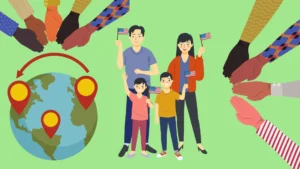
Immigration and Cultural Integration: Challenges and Benefits
Immigration has always been a fundamental part of human history, shaping societies and economies. Today, as people move across borders in search of better opportunities, safety, and new beginnings, the topic of cultural integration becomes increasingly significant. Cultural integration involves the process by which immigrants and the host society adapt to each other, creating a cohesive and inclusive environment. This blog delves into the challenges and benefits associated with cultural integration in the context of immigration.
Introduction
Cultural integration is a multifaceted process that impacts both immigrants and the host society. It requires mutual adaptation and understanding, fostering a harmonious coexistence while preserving cultural diversity. Successful integration can enhance social cohesion, economic growth, and enrich cultural landscapes. However, it also presents numerous challenges that need to be addressed thoughtfully.
Challenges of Cultural Integration
Language Barriers
One of the primary challenges immigrants face is the language barrier. Limited proficiency in the host country’s language can hinder communication, access to services, and employment opportunities. It can also contribute to social isolation and difficulty in forming meaningful connections within the community.
Employment and Economic Integration
Immigrants often encounter difficulties in finding employment that matches their skills and qualifications. Recognition of foreign credentials, discrimination, and lack of local work experience can pose significant obstacles. This underutilization of immigrant talent not only affects individual livelihoods but also the broader economy.
Social and Cultural Acceptance
Prejudice and discrimination can impede the integration process. Negative stereotypes and xenophobia create hostile environments, making it difficult for immigrants to feel accepted and valued. This social exclusion can lead to segregated communities and hinder the development of a cohesive society.
Access to Services
Navigating healthcare, education, and social services can be challenging for immigrants unfamiliar with the system. Cultural differences in understanding and accessing these services can result in disparities in health outcomes, educational attainment, and overall well-being.
Identity and Cultural Preservation
Balancing the preservation of one’s cultural identity with adapting to a new cultural environment is a delicate task. Immigrants may experience an identity crisis, feeling torn between maintaining their heritage and assimilating into the host culture. This can create intergenerational conflicts within immigrant families.
Benefits of Cultural Integration
Enriched Cultural Diversity
Cultural integration brings together diverse traditions, languages, and perspectives, enriching the cultural tapestry of the host society. This diversity fosters creativity, innovation, and a broader understanding of the world, enhancing the cultural vibrancy of communities.
Economic Growth and Innovation
Immigrants contribute significantly to the economy by filling labor shortages, starting businesses, and bringing new skills and ideas. Their diverse experiences and perspectives drive innovation, boost productivity, and create jobs, benefiting both the local and national economy.
Social Cohesion and Community Building
Successful integration promotes social cohesion by fostering mutual respect, understanding, and cooperation. Inclusive communities where immigrants are valued and supported tend to be more resilient, harmonious, and capable of addressing social challenges collectively.
Cultural Exchange and Learning
Cultural integration encourages the exchange of knowledge, traditions, and customs, fostering mutual learning and appreciation. This cultural exchange broadens horizons, challenges stereotypes, and promotes a more inclusive and empathetic society.
Strengthened Global Connections
Integrated immigrant communities create strong ties between the host country and immigrants’ countries of origin. These connections facilitate international trade, diplomacy, and cultural exchange, enhancing the host country’s global standing and influence.
Strategies for Successful Cultural Integration
Language Education and Support
Providing accessible language education and support services is crucial for helping immigrants overcome language barriers. Community-based language programs, translation services, and bilingual education can significantly aid in this process.
Inclusive Employment Practices
Promoting inclusive hiring practices and recognizing foreign credentials can help immigrants find employment that matches their skills. Mentorship programs, job training, and networking opportunities can also facilitate economic integration.
Anti-Discrimination Policies and Awareness Campaigns
Implementing and enforcing anti-discrimination policies, along with conducting awareness campaigns, can combat prejudice and promote social acceptance. Encouraging intercultural dialogue and understanding is essential for building inclusive communities.
Access to Services and Support
Ensuring that immigrants have access to healthcare, education, and social services is vital for their well-being and integration. Culturally sensitive service provision and outreach programs can bridge gaps and address disparities.
Community Engagement and Participation
Encouraging immigrants to participate in community activities, local governance, and civic life fosters a sense of belonging and ownership. Community centers, cultural festivals, and integration programs can facilitate this engagement.

Unskilled Jobs with Visa Sponsorship in Norway (2025) – Real Opportunities or Just Rumors?

Constric Are the Best Immigration Consultancy Agency in Saudi Arabia


Unlocking Dubai Dreams: Your Simple Guide on How to Get Tourist Visa for Dubai from India 2025

How to Apply for Job in Dubai – Landing Your Dream Role 2025





